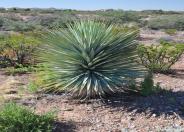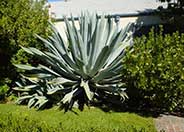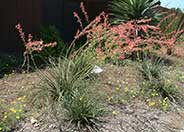
Common name:Blue Yucca
Botanical name:Yucca rigida
Evergreen treelike yucca grows at a moderate rate to 12' x 5'. Distinctive, blue gray leaves have sharp tips. Striking bluish color makes it a great accent. White clusters of flowers appear on tall stalks late spring to summer. Accepts full sun. Native to the Chihuahuan Desert in Mexico.

Common name:Century Plant, Maguey
Botanical name:Agave americana
This plant is fast growing to about 6'-10' tall and 8'-13' wide. Wide gray leaves have stiff terminal spines and recurved teeth on margins. It prefers full sun and well-drained situations. After blooming, which could take several years, it will die but will send up new pups from around the base. Some people are allergic to the sap. Removal is difficult if unwanted.

Common name:Red Yucca
Botanical name:Hesperaloe parviflora
This spectacular succulent is wonderful for a desert garden, with rosettes of gray green leaves to about 3'-4' tall and 6' wide. Red flower stalks emerge during spring and remain on the plant until the end of summer. This shrub will spread to form a crowded grass-like clump. This evergreen shrub is drought resistant but will appear better and bloom longer with added moisture. It does well in full sun, reflected heat, poor soils and cold temperatures to at least 0 degrees F.

Common name:Weeping Colorado Spruce
Botanical name:Picea pungens 'Pendula'
Picea pungens 'Pendula' is broadly spreading selection of Colorado spruce with lax, strictly weeping lateral branching. If not staked, this conifer rambles along the ground. The branches just hang limply down creating a pole like appearance with the bottom branches creeping across the ground. It is a robust growing plant, with terminal buds extending 1 foot (30 cm) or more on a yearly basis. Ultimate height is determined by the height of the stake used to support the young plant. Needles are bright Blue that fade to dark green in their second year. Internal and shaded foliage is also more green than Blue in color.
Designer: Linda McSwain (retired)
Photographer: Vicki Anderson
Maintain a two to four inch layer of mulch on the soil surface to reduce weeds, infiltrate rain water, and reduce compaction.
Attract, or buy beneficial insects such as ladybugs and lacewings to control pest outbreaks in your garden.